Poole Ch.P., Jr. Handbook of Superconductivity
Подождите немного. Документ загружается.

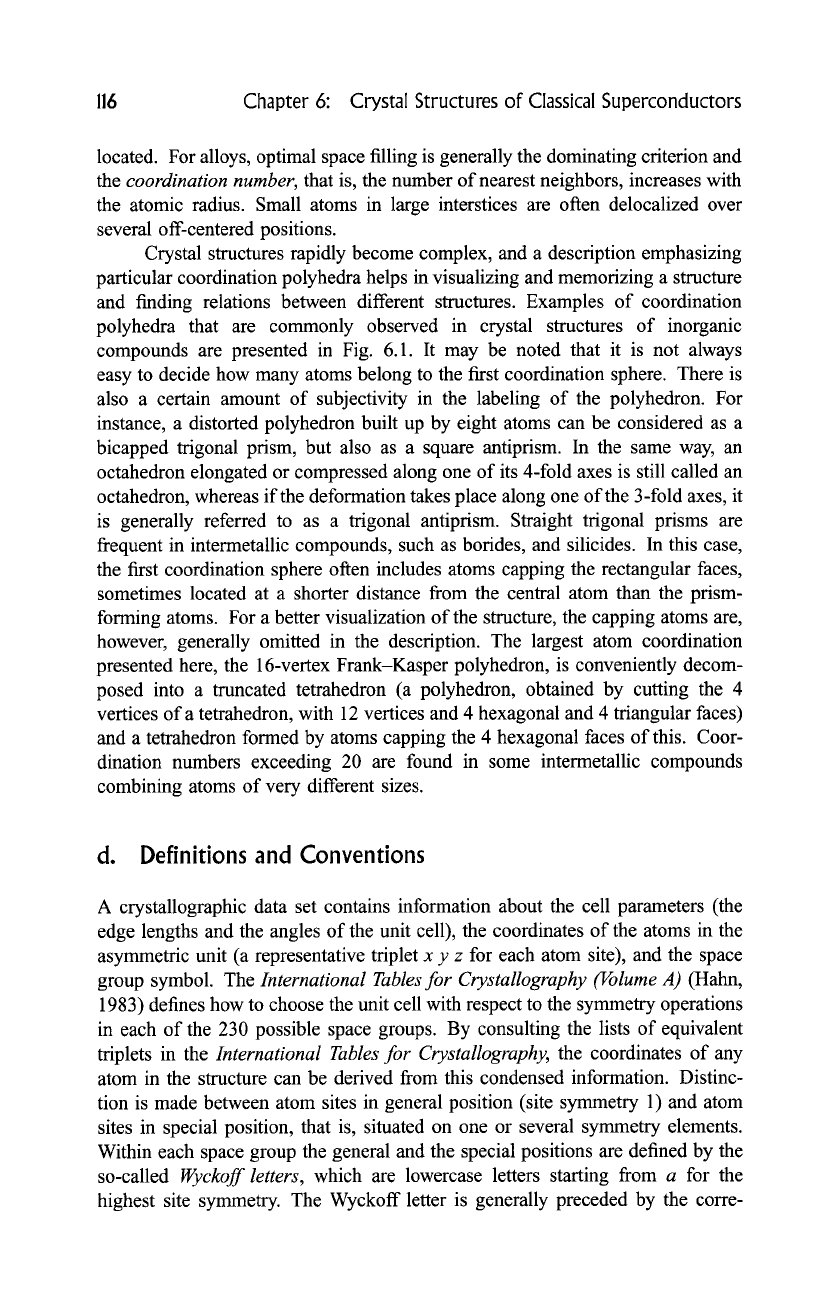
116 Chapter 6: Crystal Structures of Classical Superconductors
located. For alloys, optimal space filling is generally the dominating criterion and
the
coordination number,
that is, the number of nearest neighbors, increases with
the atomic radius. Small atoms in large interstices are often delocalized over
several off-centered positions.
Crystal structures rapidly become complex, and a description emphasizing
particular coordination polyhedra helps in visualizing and memorizing a structure
and finding relations between different structures. Examples of coordination
polyhedra that are commonly observed in crystal structures of inorganic
compounds are presented in Fig. 6.1. It may be noted that it is not always
easy to decide how many atoms belong to the first coordination sphere. There is
also a certain amount of subjectivity in the labeling of the polyhedron. For
instance, a distorted polyhedron built up by eight atoms can be considered as a
bicapped trigonal prism, but also as a square antiprism. In the same way, an
octahedron elongated or compressed along one of its 4-fold axes is still called an
octahedron, whereas if the deformation takes place along one of the 3-fold axes, it
is generally referred to as a trigonal antiprism. Straight trigonal prisms are
frequent in intermetallic compounds, such as borides, and silicides. In this case,
the first coordination sphere often includes atoms capping the rectangular faces,
sometimes located at a shorter distance from the central atom than the prism-
forming atoms. For a better visualization of the structure, the capping atoms are,
however, generally omitted in the description. The largest atom coordination
presented here, the 16-vertex Frank-Kasper polyhedron, is conveniently decom-
posed into a truncated tetrahedron (a polyhedron, obtained by cutting the 4
vertices of a tetrahedron, with 12 vertices and 4 hexagonal and 4 triangular faces)
and a tetrahedron formed by atoms capping the 4 hexagonal faces of this. Coor-
dination numbers exceeding 20 are found in some intermetallic compounds
combining atoms of very different sizes.
d. Definitions and Conventions
A crystallographic data set contains information about the cell parameters (the
edge lengths and the angles of the unit cell), the coordinates of the atoms in the
asymmetric unit (a representative triplet x y z for each atom site), and the space
group symbol. The
International Tables for Crystallography (Volume A)
(Hahn,
1983) defines how to choose the unit cell with respect to the symmetry operations
in each of the 230 possible space groups. By consulting the lists of equivalent
triplets in the
International Tables for Crystallography,
the coordinates of any
atom in the structure can be derived from this condensed information. Distinc-
tion is made between atom sites in general position (site symmetry 1) and atom
sites in special position, that is, situated on one or several symmetry elements.
Within each space group the general and the special positions are defined by the
so-called
Wyckoff letters,
which are lowercase letters starting from a for the
highest site symmetry. The Wyckoff letter is generally preceded by the corre-
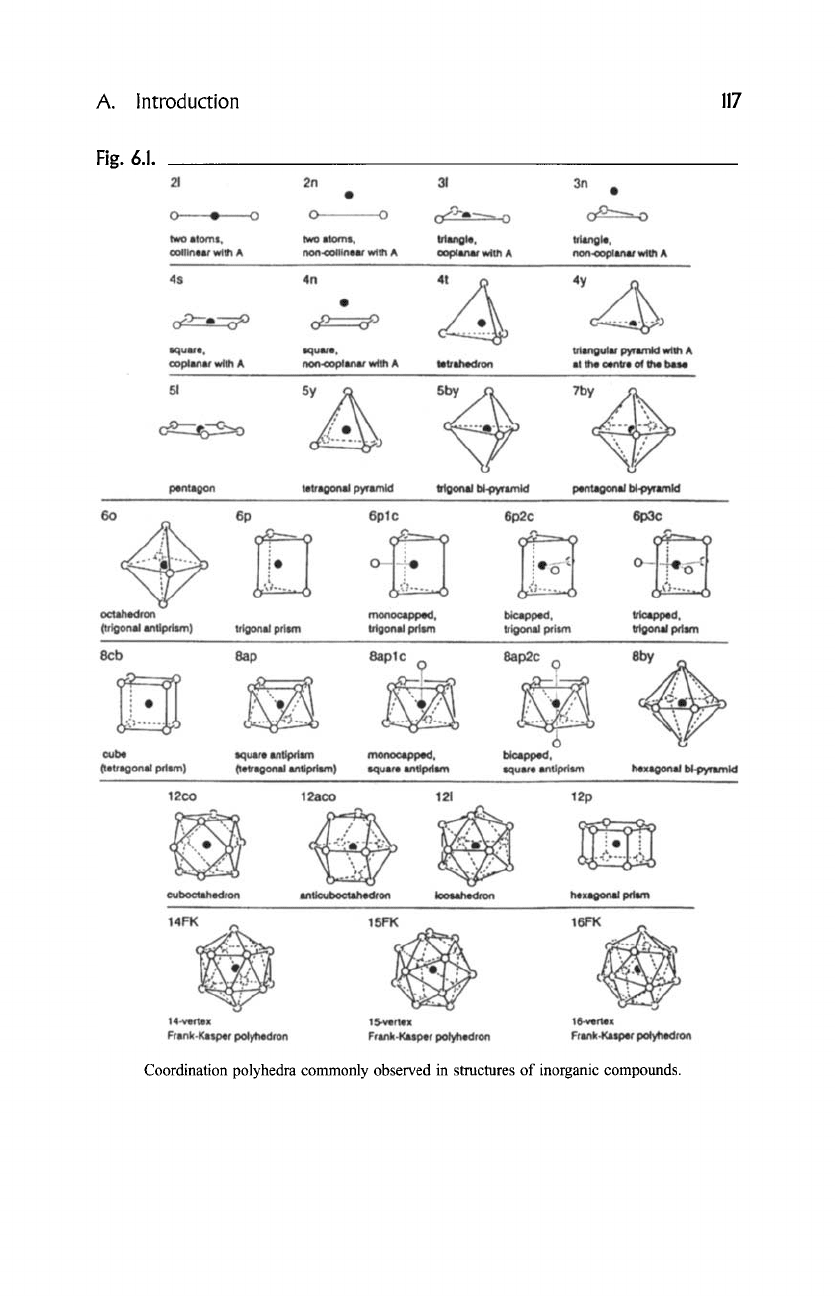
A.
Introduction 117
Fig. 6.1.
Coordination polyhedra commonly observed in structures of inorganic compounds.
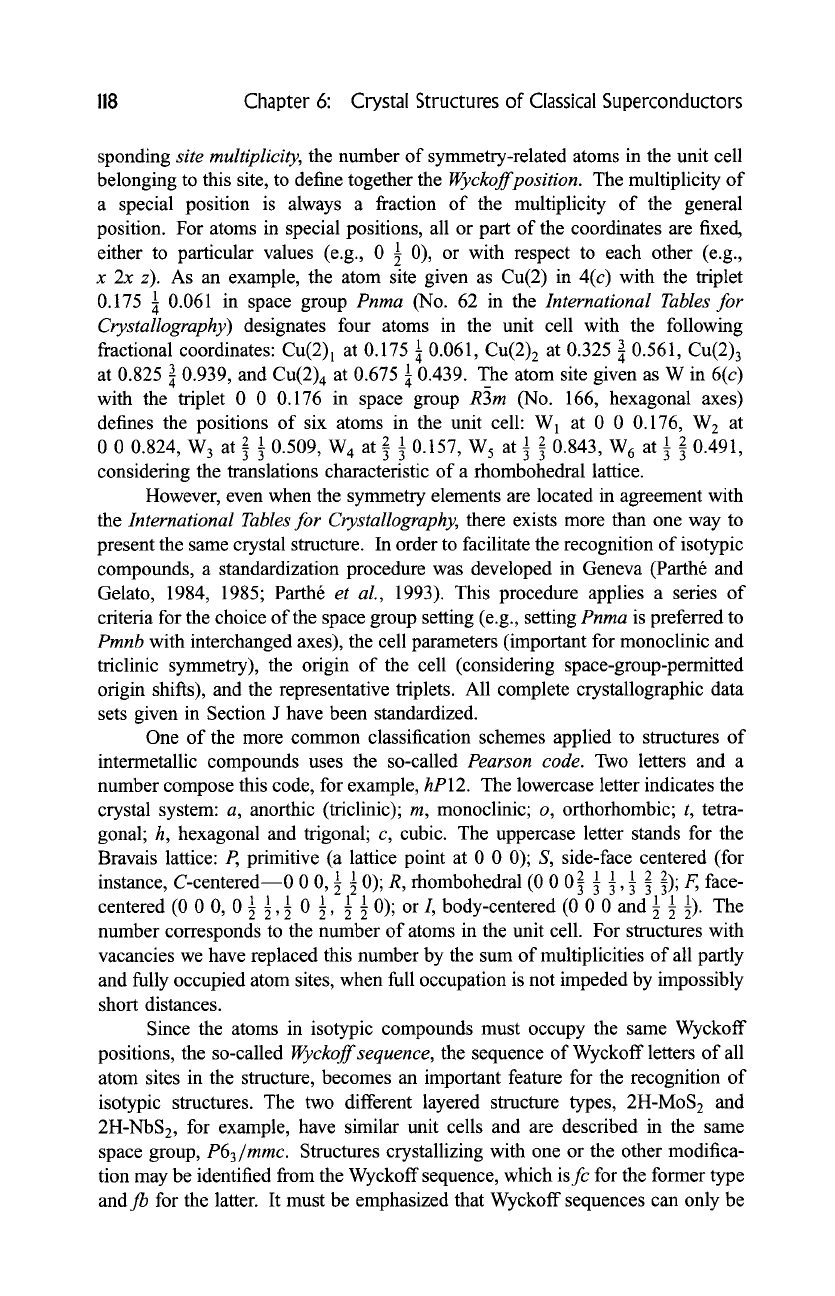
118 Chapter 6: Crystal Structures of Classical Superconductors
sponding site multiplicity, the number of symmetry-related atoms in the unit cell
belonging to this site, to define together the Wyckoffposition. The multiplicity of
a special position is always a fraction of the multiplicity of the general
position. For atoms in special positions, all or part of the coordinates are fixed,
either to particular values (e.g., 0 1 0), or with respect to each other (e.g.,
x 2x z). As an example, the atom site given as Cu(2) in 4(c) with the triplet
0.175 88 0.061 in space group Pnma (No. 62 in the International Tables for
Crystallography) designates four atoms in the unit cell with the following
fractional coordinates: Cu(2)l at 0.175 ~ 0.061, Cu(2)2 at 0.325 3 0.561, Cu(2)3
at 0.825 43- 0.939, and Cu(2)4 at 0.675 88 0.439. The_ atom site given as W in 6(c)
with the triplet 0 0 0.176 in space group R3m (No. 166, hexagonal axes)
defines the positions of six atoms in the unit cell: W1 at 0 0 0.176, W2 at
0 0 0.824, W 3 at~ 89 0.509, W 4 at 2 89 0.157, W 5 at89 2 0.843,
W 6
at 89 2 0.491,
considering the translations characteristic of a rhombohedral lattice.
However, even when the symmetry elements are located in agreement with
the International Tables for Crystallography, there exists more than one way to
present the same crystal structure. In order to facilitate the recognition of isotypic
compounds, a standardization procedure was developed in Geneva (Parth6 and
Gelato, 1984, 1985; Parth6 et aL, 1993). This procedure applies a series of
criteria for the choice of the space group setting (e.g., setting Pnma is preferred to
Pmnb with interchanged axes), the cell parameters (important for monoclinic and
triclinic symmetry), the origin of the cell (considering space-group-permitted
origin shifts), and the representative triplets. All complete crystallographic data
sets given in Section J have been standardized.
One of the more common classification schemes applied to structures of
intermetallic compounds uses the so-called Pearson code. Two letters and a
number compose this code, for example, hP12. The lowercase letter indicates the
crystal system: a, anorthic (triclinic); m, monoclinic; o, orthorhombic; t, tetra-
gonal; h, hexagonal and trigonal; c, cubic. The uppercase letter stands for the
Bravais lattice: P, primitive (a lattice point at 0 0 0); S, side-face centered (for
instance, C-centered--0 0 0, 89 89 0); R, rhombohedral (0 0 023313'311232);
F~
face-
centered (0 0 0, 0 1 89189 0 89 89 89 0); or I, body-centered (0 0 0 and 89 1 89 The
number corresponds to the number of atoms in the unit cell. For structures with
vacancies we have replaced this number by the sum of multiplicities of all partly
and fully occupied atom sites, when full occupation is not impeded by impossibly
short distances.
Since the atoms in isotypic compounds must occupy the same Wyckoff
positions, the so-called Wyckoffsequence, the sequence of Wyckoff letters of all
atom sites in the structure, becomes an important feature for the recognition of
isotypic structures. The two different layered structure types, 2H-MoS 2 and
2H-NbS2, for example, have similar unit cells and are described in the same
space group, P63/mmc. Structures crystallizing with one or the other modifica-
tion may be identified from the Wyckoff sequence, which isfc for the former type
and fb for the latter. It must be emphasized that Wyckoff sequences can only be
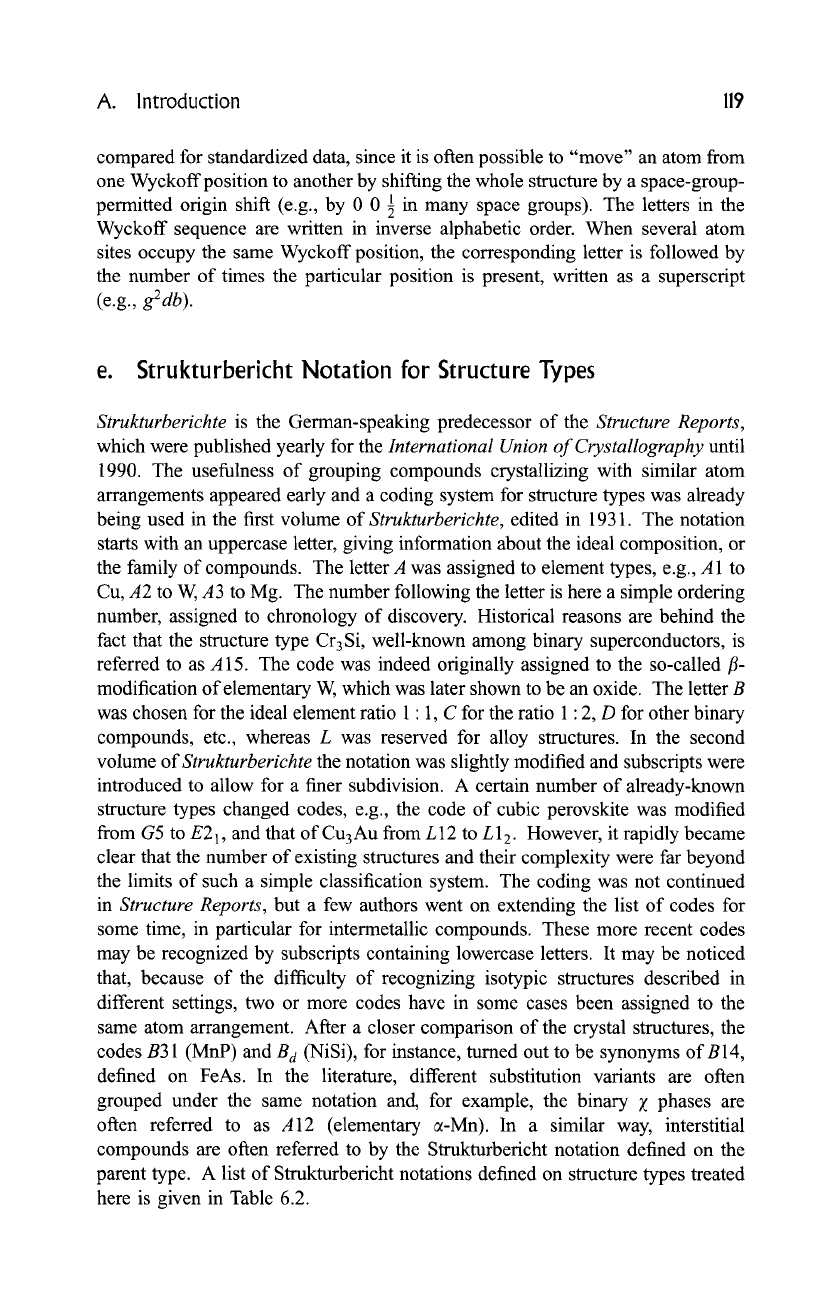
A. Introduction 119
compared for standardized data, since it is often possible to "move" an atom from
one Wyckoff position to another by shifting the whole structure by a space-group-
permitted origin shift (e.g., by 0 0 89 in many space groups). The letters in the
Wyckoff sequence are written in inverse alphabetic order. When several atom
sites occupy the same Wyckoff position, the corresponding letter is followed by
the number of times the particular position is present, written as a superscript
(e.g.,
g2db).
e. Strukturbericht Notation for Structure Types
Strukturberichte
is the German-speaking predecessor of the
Structure Reports,
which were published yearly for the
International Union of Crystallography
until
1990. The usefulness of grouping compounds crystallizing with similar atom
arrangements appeared early and a coding system for structure types was already
being used in the first volume of
Strukturberichte,
edited in 1931. The notation
starts with an uppercase letter, giving information about the ideal composition, or
the family of compounds. The letter A was assigned to element types, e.g., A 1 to
Cu, A2 to W, A3 to Mg. The number following the letter is here a simple ordering
number, assigned to chronology of discovery. Historical reasons are behind the
fact that the structure type Cr3Si, well-known among binary superconductors, is
referred to as A 15. The code was indeed originally assigned to the so-called r-
modification of elementary W, which was later shown to be an oxide. The letter B
was chosen for the ideal element ratio 1 : 1, C for the ratio 1:2, D for other binary
compounds, etc., whereas L was reserved for alloy structures. In the second
volume of
Strukturberichte
the notation was slightly modified and subscripts were
introduced to allow for a finer subdivision. A certain number of already-known
structure types changed codes, e.g., the code of cubic perovskite was modified
from G5 to E21, and that of CuaAu from L12 to L12. However, it rapidly became
clear that the number of existing structures and their complexity were far beyond
the limits of such a simple classification system. The coding was not continued
in
Structure Reports,
but a few authors went on extending the list of codes for
some time, in particular for intermetallic compounds. These more recent codes
may be recognized by subscripts containing lowercase letters. It may be noticed
that, because of the difficulty of recognizing isotypic structures described in
different settings, two or more codes have in some cases been assigned to the
same atom arrangement. After a closer comparison of the crystal structures, the
codes B31 (MnP) and
B d
(NiSi), for instance, turned out to be synonyms of B14,
defined on FeAs. In the literature, different substitution variants are often
grouped under the same notation and, for example, the binary Z phases are
often referred to as A12 (elementary ~-Mn). In a similar way, interstitial
compounds are often referred to by the Strukturbericht notation defined on the
parent type. A list of Strukturbericht notations defined on structure types treated
here is given in Table 6.2.
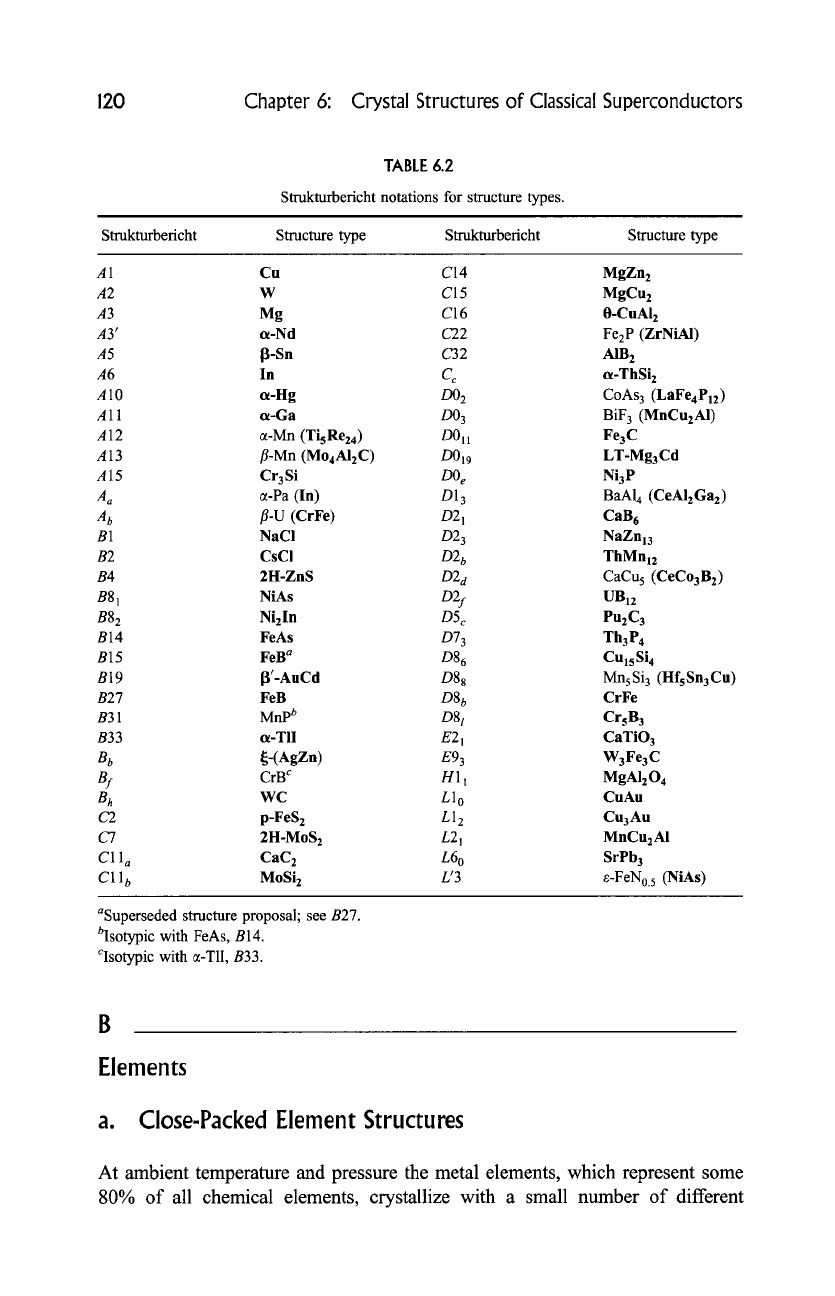
120 Chapter 6: Crystal Structures of Classical Superconductors
TABLE
6.2
Smd~rbericht notations for structure types.
Stmkturbericht Structure type S~bericht Structure type
A1
A2
A3
A3'
A5
A6
A10
All
A12
A13
A15
Aa
Ab
B1
B2
B4
B81
B82
B14
B15
B19
B27
B31
B33
Bb
Bh
C2
C7
Cll a
Cll b
Cu C14 MgZn z
W C15
MgCu z
Mg C16 0-CuAI z
~t-Nd C22 Fe2P (ZrNiAI)
13-Sn C32 AIB 2
In
C c
ot-ThSi z
a-Hg D02 CoAs 3 (LaFe4P12)
a-Ga D03 BiF 3 (MnCu2AI)
a-Mn (TisRe24) D011 Fe3C
fl-Mn (Mo4AI2C) D019 LT-Mg3Cd
Cr3Si
DO e
Ni3P
a-Pa (In) D13 BaA14 (CeAl2Ga2)
fl-U (CrFe) D21 CaB 6
NaCl D2 3 NaZnl3
CsCI
D2 b
ThMnl2
2H-ZnS
D2 d
CaCu 5 (CeCo3B2)
NiAs
D2f
UB12
Ni2In
D5c
Pu2C3
FeAs D7 3 ThaP 4
FeB a D8 6 Cul5Si4
[3'-AuCd D8 8 MnsSi 3 (HfsSnaCu)
FeB
D8 b
CrFe
MnP b D8 l
CrsB3
~t-TlI E21 CaTiO 3
~-(AgZn) E9 3 W3Fe3C
CrB ~ H 11 MgAI2 O4
WC L1 o
CuAu
p-FeS 2 L 12 Cu3Au
2H-MoS 2 L21 MnCu2AI
CaC 2 L6 0 SrPb 3
MoSi 2 L'3 e-FeNo. 5 (NiAs)
aSuperseded structure proposal; see B27.
blsotypic with FeAs, B 14.
r with a-TII, B33.
Elements
a. Close-Packed Element Structures
At ambient temperature and pressure the metal elements, which represent some
80% of all chemical elements, crystallize with a small number of different
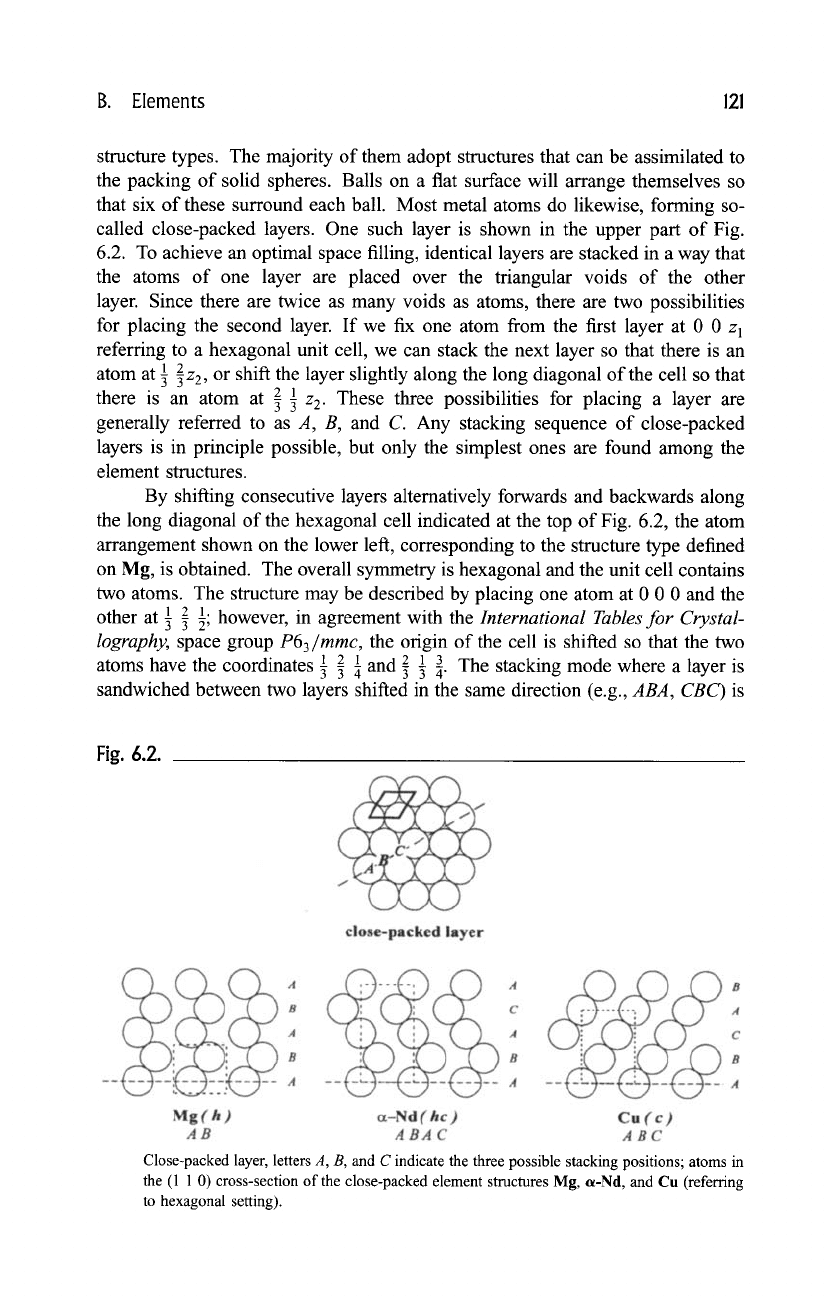
B. Elements 121
structure types. The majority of them adopt structures that can be assimilated to
the packing of solid spheres. Balls on a flat surface will arrange themselves so
that six of these surround each ball. Most metal atoms do likewise, forming so-
called close-packed layers. One such layer is shown in the upper part of Fig.
6.2. To achieve an optimal space filling, identical layers are stacked in a way that
the atoms of one layer are placed over the triangular voids of the other
layer. Since there are twice as many voids as atoms, there are two possibilities
for placing the second layer. If we fix one atom from the first layer at 0 0 z 1
referring to a hexagonal unit cell, we can stack the next layer so that there is an
atom at
1 2 Z
2, or shift the layer slightly along the long diagonal of the cell so that
there is an atom at 2 89 z2" These three possibilities for placing a layer are
generally referred to as A, B, and C. Any stacking sequence of close-packed
layers is in principle possible, but only the simplest ones are found among the
element structures.
By shifting consecutive layers alternatively forwards and backwards along
the long diagonal of the hexagonal cell indicated at the top of Fig. 6.2, the atom
arrangement shown on the lower left, corresponding to the structure type defined
on Mg, is obtained. The overall symmetry is hexagonal and the unit cell contains
two atoms. The structure may be described by placing one atom at 0 0 0 and the
other at 89 2 89 however, in agreement with the
International Tables for Crystal-
lography,
space group
P63/mmc,
the origin of the cell is shifted so that the two
atoms have the coordinates 89 2 88 and 2 89 ~. The stacking mode where a layer is
sandwiched between two layers shifted in the same direction (e.g.,
ABA, CBC)
is
Fig. 6.2.
Close-packed layer, letters A, B, and C indicate the three possible stacking positions; atoms in
the (1 1 0) cross-section of the close-packed element structures Mg, a-Nd, and Cu (referring
to hexagonal setting).
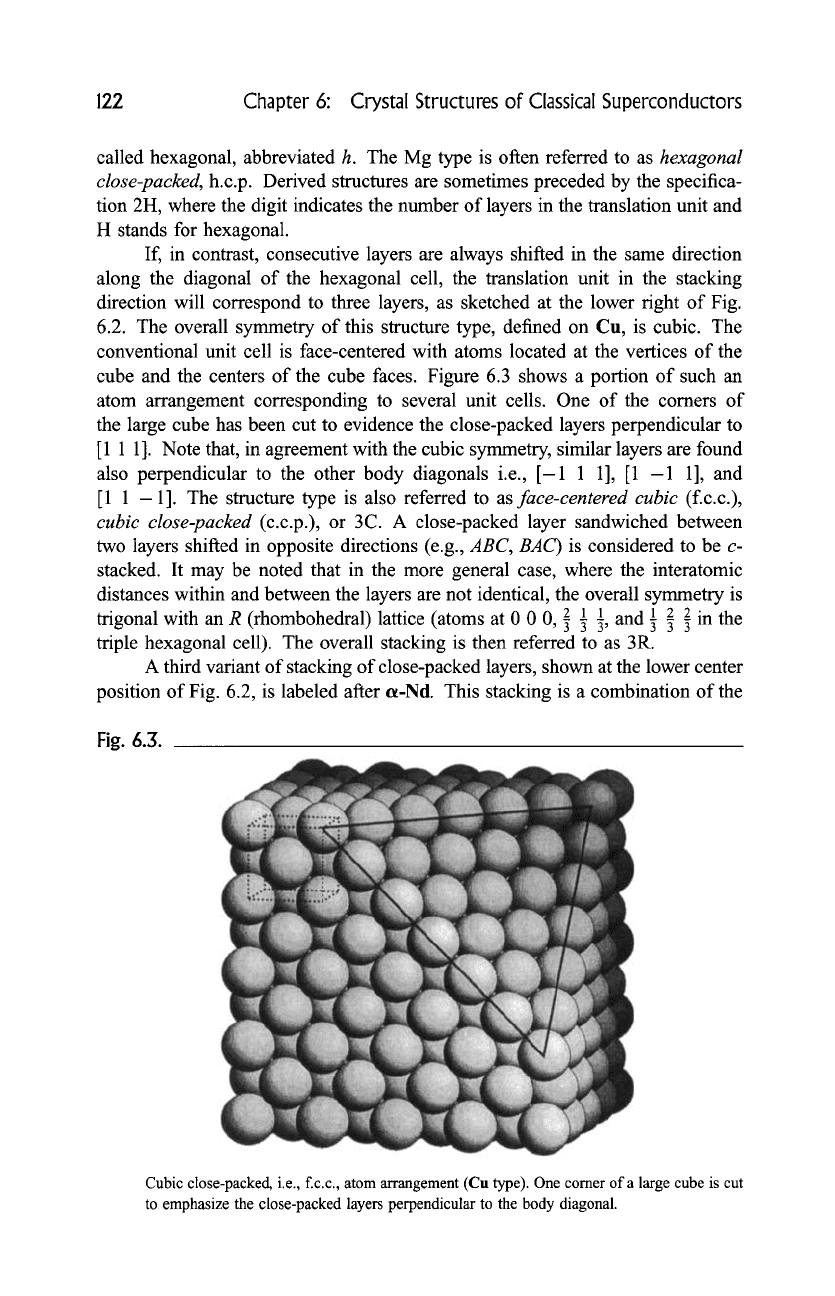
122 Chapter 6: Crystal Structures of Classical Superconductors
called hexagonal, abbreviated h. The Mg type is often referred to as
hexagonal
close-packed,
h.c.p. Derived structures are sometimes preceded by the specifica-
tion 2H, where the digit indicates the number of layers in the translation unit and
H stands for hexagonal.
If, in contrast, consecutive layers are always shifted in the same direction
along the diagonal of the hexagonal cell, the translation unit in the stacking
direction will correspond to three layers, as sketched at the lower fight of Fig.
6.2. The overall symmetry of this structure type, defined on Cu, is cubic. The
conventional unit cell is face-centered with atoms located at the vertices of the
cube and the centers of the cube faces. Figure 6.3 shows a portion of such an
atom arrangement corresponding to several unit cells. One of the comers of
the large cube has been cut to evidence the close-packed layers perpendicular to
[1 1 1]. Note that, in agreement with the cubic symmetry, similar layers are found
also perpendicular to the other body diagonals i.e., [-1 1 1], [1 -1 1], and
[1 1 -1]. The structure type is also referred to as
face-centered cubic
(f.c.c.),
cubic close-packed
(c.c.p.), or 3C. A close-packed layer sandwiched between
two layers shifted in opposite directions (e.g.,
ABC, BAC)
is considered to be c-
stacked. It may be noted that in the more general case, where the interatomic
distances within and between the layers are not identical, the overall symmetry is
trigonal with an R (rhombohedral) lattice (atoms at 0 0 0, 2 1 1, and 1 2 2 in the
triple hexagonal cell). The overall stacking is then referred to as 3R.
A third variant of stacking of close-packed layers, shown at the lower center
position of Fig. 6.2, is labeled after t~-Nd. This stacking is a combination of the
Fig. 6.3.
Cubic close-packed, i.e., f.c.c., atom arrangement (Cu type). One comer of a large cube is cut
to emphasize the close-packed layers perpendicular to the body diagonal.
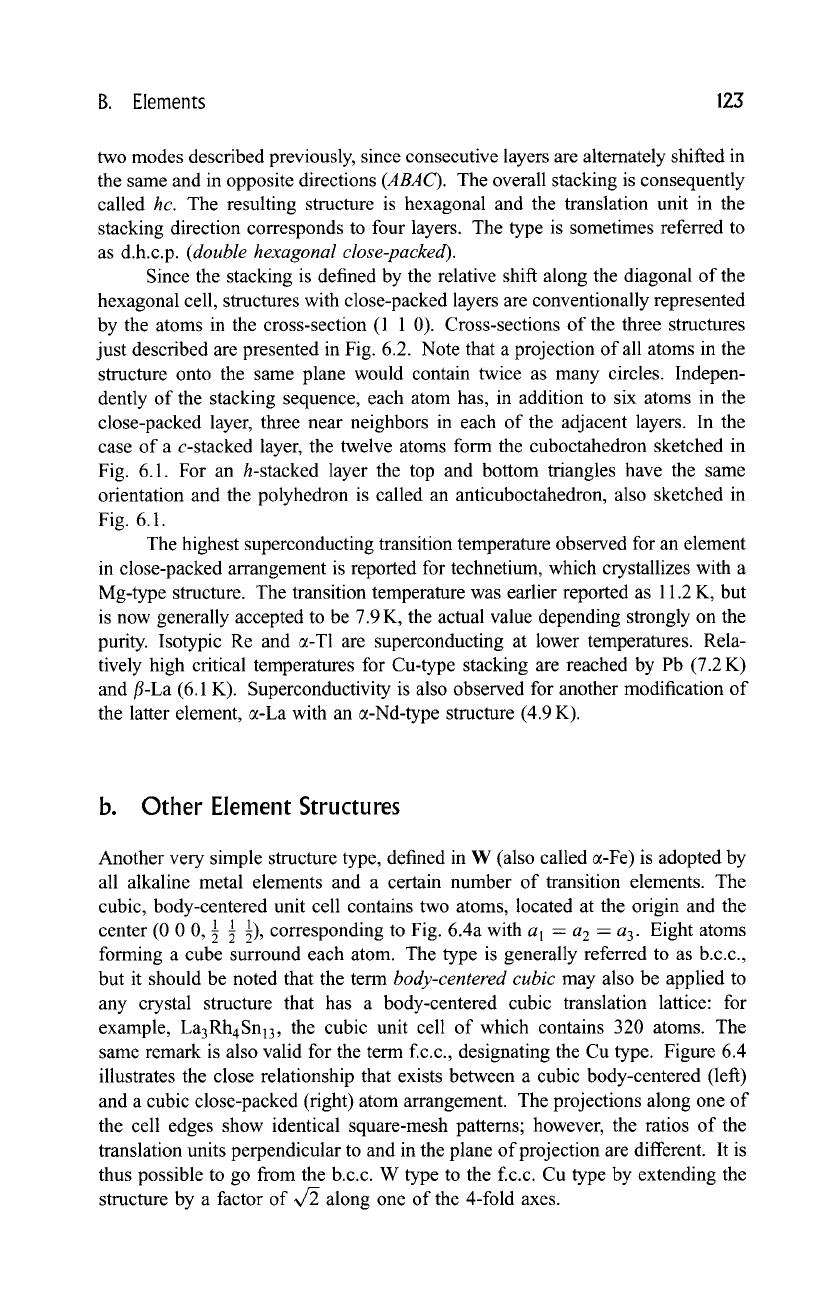
B. Elements 123
two modes described previously, since consecutive layers are alternately shifted in
the same and in opposite directions (ABAC). The overall stacking is consequently
called hc. The resulting structure is hexagonal and the translation unit in the
stacking direction corresponds to four layers. The type is sometimes referred to
as d.h.c.p. (double hexagonal close-packed).
Since the stacking is defined by the relative shift along the diagonal of the
hexagonal cell, structures with close-packed layers are conventionally represented
by the atoms in the cross-section (1 1 0). Cross-sections of the three structures
just described are presented in Fig. 6.2. Note that a projection of all atoms in the
structure onto the same plane would contain twice as many circles. Indepen-
dently of the stacking sequence, each atom has, in addition to six atoms in the
close-packed layer, three near neighbors in each of the adjacent layers. In the
case of a c-stacked layer, the twelve atoms form the cuboctahedron sketched in
Fig. 6.1. For an h-stacked layer the top and bottom triangles have the same
orientation and the polyhedron is called an anticuboctahedron, also sketched in
Fig. 6.1.
The highest superconducting transition temperature observed for an element
in close-packed arrangement is reported for technetium, which crystallizes with a
Mg-type structure. The transition temperature was earlier reported as 11.2 K, but
is now generally accepted to be 7.9 K, the actual value depending strongly on the
purity. Isotypic Re and c~-T1 are superconducting at lower temperatures. Rela-
tively high critical temperatures for Cu-type stacking are reached by Pb (7.2 K)
and/%La (6.1 K). Superconductivity is also observed for another modification of
the latter element, c~-La with an c~-Nd-type structure (4.9 K).
b. Other Element Structures
Another very simple structure type, defined in W (also called c~-Fe) is adopted by
all alkaline metal elements and a certain number of transition elements. The
cubic, body-centered unit cell contains two atoms, located at the origin and the
center (0 0 0, 1 89 89 corresponding to Fig. 6.4a with a 1 - a 2 - a 3. Eight atoms
forming a cube surround each atom. The type is generally referred to as b.c.c.,
but it should be noted that the term body-centered cubic may also be applied to
any crystal structure that has a body-centered cubic translation lattice: for
example, La3Rh4Snl3 , the cubic unit cell of which contains 320 atoms. The
same remark is also valid for the term f.c.c., designating the Cu type. Figure 6.4
illustrates the close relationship that exists between a cubic body-centered (left)
and a cubic close-packed (fight) atom arrangement. The projections along one of
the cell edges show identical square-mesh patterns; however, the ratios of the
translation units perpendicular to and in the plane of projection are different. It is
thus possible to go from the b.c.c. W type to the f.c.c. Cu type by extending the
structure by a factor of v/2 along one of the 4-fold axes.
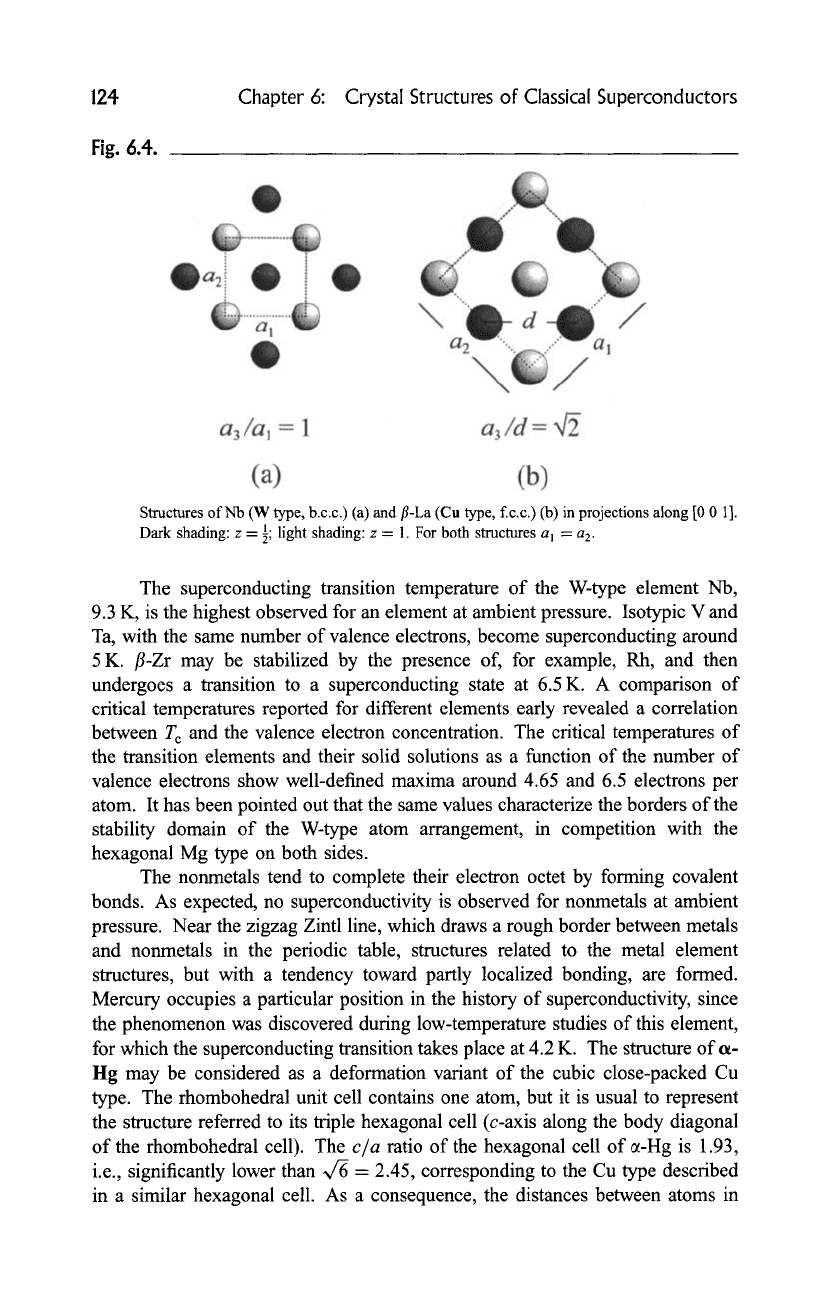
124 Chapter 6: Crystal Structures of Classical Superconductors
Fig. 6.4.
Structures ofNb (W type, b.c.c.) (a) and fl-La (Cu type, f.c.c.) (b) in projections along [0 0 1].
Dark shading: z - 1; light shading: z - 1. For both structures a 1
--
a 2.
The superconducting transition temperature of the W-type element Nb,
9.3 K, is the highest observed for an element at ambient pressure. Isotypic V and
Ta, with the same number of valence electrons, become superconducting around
5 K. fl-Zr may be stabilized by the presence of, for example, Rh, and then
undergoes a transition to a superconducting state at 6.5 K. A comparison of
critical temperatures reported for different elements early revealed a correlation
between T c and the valence electron concentration. The critical temperatures of
the transition elements and their solid solutions as a function of the number of
valence electrons show well-defined maxima around 4.65 and 6.5 electrons per
atom. It has been pointed out that the same values characterize the borders of the
stability domain of the W-type atom arrangement, in competition with the
hexagonal Mg type on both sides.
The nonmetals tend to complete their electron octet by forming covalent
bonds. As expected, no superconductivity is observed for nonmetals at ambient
pressure. Near the zigzag Zintl line, which draws a rough border between metals
and nonmetals in the periodic table, structures related to the metal element
structures, but with a tendency toward partly localized bonding, are formed.
Mercury occupies a particular position in the history of superconductivity, since
the phenomenon was discovered during low-temperature studies of this element,
for which the superconducting transition takes place at 4.2 K. The structure of o~-
Itg may be considered as a deformation variant of the cubic close-packed Cu
type. The rhombohedral unit cell contains one atom, but it is usual to represent
the structure referred to its triple hexagonal cell (c-axis along the body diagonal
of the rhombohedral cell). The
c/a
ratio of the hexagonal cell of a-Hg is 1.93,
i.e., significantly lower than ~ = 2.45, corresponding to the Cu type described
in a similar hexagonal cell. As a consequence, the distances between atoms in
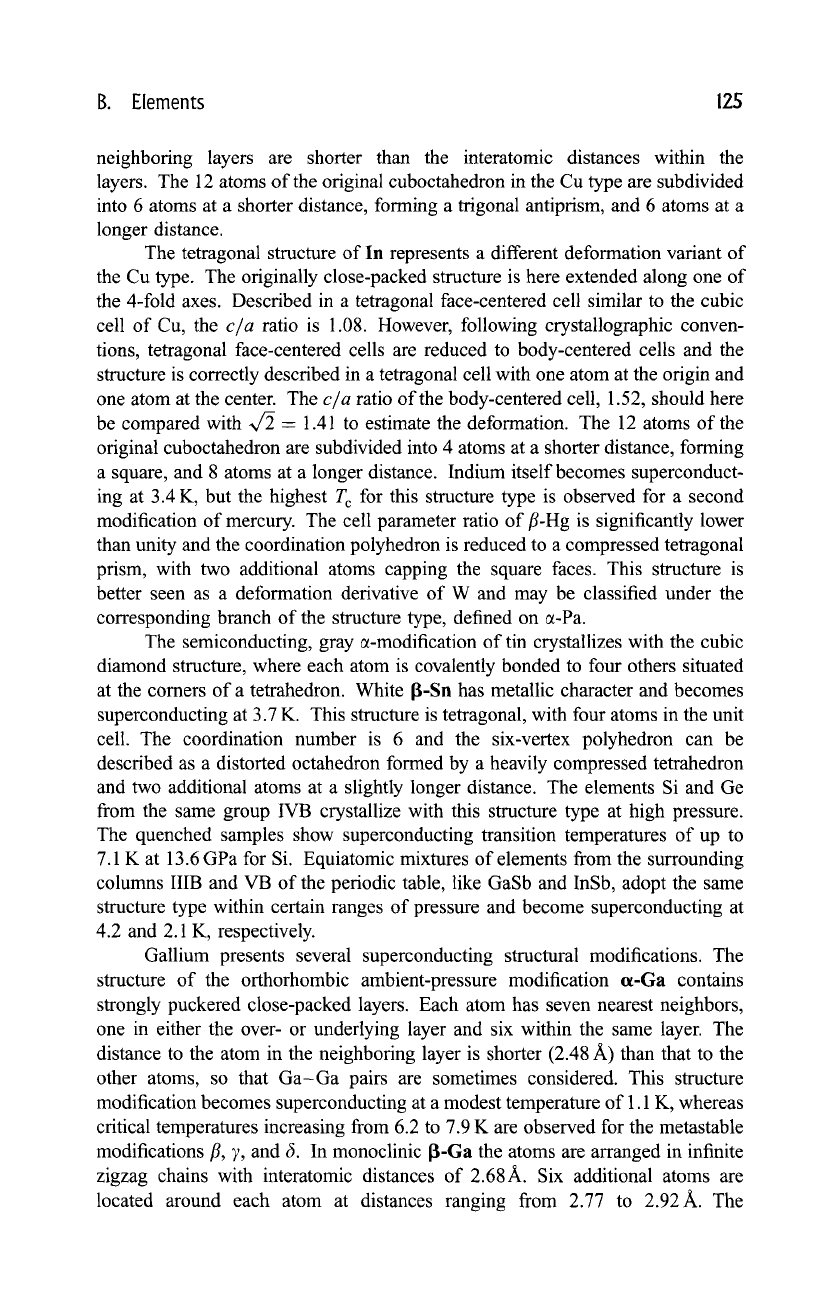
B. Elements 125
neighboring layers are shorter than the interatomic distances within the
layers. The 12 atoms of the original cuboctahedron in the Cu type are subdivided
into 6 atoms at a shorter distance, forming a trigonal antiprism, and 6 atoms at a
longer distance.
The tetragonal structure of In represents a different deformation variant of
the Cu type. The originally close-packed structure is here extended along one of
the 4-fold axes. Described in a tetragonal face-centered cell similar to the cubic
cell of Cu, the
c/a
ratio is 1.08. However, following crystallographic conven-
tions, tetragonal face-centered cells are reduced to body-centered cells and the
structure is correctly described in a tetragonal cell with one atom at the origin and
one atom at the center. The
c/a
ratio of the body-centered cell, 1.52, should here
be compared with x/2 - 1.41 to estimate the deformation. The 12 atoms of the
original cuboctahedron are subdivided into 4 atoms at a shorter distance, forming
a square, and 8 atoms at a longer distance. Indium itself becomes superconduct-
ing at 3.4 K, but the highest T c for this structure type is observed for a second
modification of mercury. The cell parameter ratio of fl-Hg is significantly lower
than unity and the coordination polyhedron is reduced to a compressed tetragonal
prism, with two additional atoms capping the square faces. This structure is
better seen as a deformation derivative of W and may be classified under the
corresponding branch of the structure type, defined on a-Pa.
The semiconducting, gray a-modification of tin crystallizes with the cubic
diamond structure, where each atom is covalently bonded to four others situated
at the comers of a tetrahedron. White [3-Sn has metallic character and becomes
superconducting at 3.7 K. This structure is tetragonal, with four atoms in the unit
cell. The coordination number is 6 and the six-vertex polyhedron can be
described as a distorted octahedron formed by a heavily compressed tetrahedron
and two additional atoms at a slightly longer distance. The elements Si and Ge
from the same group IVB crystallize with this structure type at high pressure.
The quenched samples show superconducting transition temperatures of up to
7.1 K at 13.6 GPa for Si. Equiatomic mixtures of elements from the surrounding
columns IIIB and VB of the periodic table, like GaSb and InSb, adopt the same
structure type within certain ranges of pressure and become superconducting at
4.2 and 2.1 K, respectively.
Gallium presents several superconducting structural modifications. The
structure of the orthorhombic ambient-pressure modification ~-Ga contains
strongly puckered close-packed layers. Each atom has seven nearest neighbors,
one in either the over- or underlying layer and six within the same layer. The
distance to the atom in the neighboring layer is shorter (2.48 ~) than that to the
other atoms, so that Ga-Ga pairs are sometimes considered. This structure
modification becomes superconducting at a modest temperature of 1.1 K, whereas
critical temperatures increasing from 6.2 to 7.9 K are observed for the metastable
modifications r, 7, and ~. In monoclinic [~-Ga the atoms are arranged in infinite
zigzag chains with interatomic distances of 2.68/~. Six additional atoms are
located around each atom at distances ranging from 2.77 to 2.92A. The
